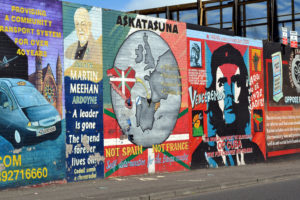Upon exiting the taxi, a young boy passed me on a bike and uttered an obscenity.
Such are the everyday tensions one experiences in the working class neighborhood of Belfast, Northern Ireland – the epicenter of the very uneasy peace between Catholics and Protestants.
A wall, similar to the old Berlin Wall, divides Catholics from Protestants.
The Catholics want complete independence from existing British rule. The Protestants want just the opposite. The two sides have been resisting each other so long that resistance is seared into their souls.
It’s not unusual to see young men walking their massive English Mastiff guard dogs. You best not stare too long, for a slight glance can set things off.
There are Catholic taxis, Protestant taxis, and “neutral” taxis. Our taxi was a neutral one, so we were able to visit both Protestant and Catholic sides. Wall after wall is painted with angry resistance rhetoric like, “Resistance brings freedom.”
A human’s wrath “hath no end” when a philosophy of resistance is at the core of one’s identity. Extreme resistance attracts sociopaths, whose brutality is mistaken for heroic acts of defense. Somehow the acts of these kind of people are always the same: they cause the blood of the innocent to flow through the gutters of every neighborhood.
On the Protestant side, Stevie “Top Gun” Mckeaq was probably the most notorious of these militant resistors, having murdered at least fourteen Catholics. Mere blocks, if that, separate the two sides.
My Observations
I’ve seen too many walls like the one in Belfast to last me a lifetime.
The wall dividing Palestinians from Jews in East Jerusalem is a case in point. After traveling in and out of Jerusalem for a decade, I became very familiar with separatists, who make resistance a way of life. They become hardened, and each generation becomes harder than the preceding one.
Resistance evolves into “resistance for the sake of resistance.” Separatist leaders become more and more powerful by reinforcing resistance.
A Young Man’s Myth
I remember believing as a young man that all these kinds of tensions would resolve themselves within my lifetime. I am no longer inclined to believe this way. In fact, if anything, I have concluded that resistance is part of the human character.
In sports, resistance comes in the form of competition. We defend our goal, and then drive to the competitor’s goal, until victory is accomplished.
In business, we defend market share by resisting the advances of our competitor by pointing out our strengths vis a vis their weaknesses.
Resistance forces us to take a position and uphold it. For example, we do this in preserving traditional values within our culture. Personally, I feel a little empty that the home I grew up in was demolished shortly after my family moved out. It is now a parking lot. Because of this, I empathize with those who resist the destruction of old neighborhoods in the name of progress.
Resistance Turns To A Resistance Movement
Because resistance is so basic to our human character, we need ways to mediate it, so it doesn’t get out of hand and become counterproductive.
For example, our political system, which in part is based on a system of political parties, has functioned well in mediating resistance. Each party supports delegates who run for office. If they are elected, they go to governing bodies where compromises are reached on competing interests. Resistance wanes as all sides give in a little, in order to get a little.
However, there are times when the system doesn’t work well enough, and instead of compromise, greater resistance builds up.
For example, right now the United States Congress is witnessing a great deal of resistance from “The Tea Party” wing of the Republican Party. The Tea Party wants drastic cuts in the federal budget and no new revenue enhancements (taxes).
Sooner or later, a compromise will be worked out. But, if not, then The Tea Party could move from resistance to a “resistance movement.” At that point, Tea Party members run the risk of becoming separatists. As separatists, the game changes. At that point, the rules support deceit, dishonesty, and potential violence to resist and defeat their enemy.
I don’t believe The Tea Party’s resistance will come to that, nevertheless, historically, that seems to be the cycle of resistance if compromise is not forthcoming.
Some Good News
In 1994,The Irish Revolutionary Army (IRA), the military resistance group representing Irish Catholics, disarmed and let their political affiliate Sinn Fein, negotiate a peace accord with the Protestants.
Even though the wall that divides the two sides still stands, as you go out from downtown, you’ll find Catholics and Protestants living and working alongside each other. The increased prosperity in these areas is very noticeable.
Resistance in life has its place, but it also has its limits. Prosperity usually follows when separation ends and peace begins, no matter how fragile that peace may be.
